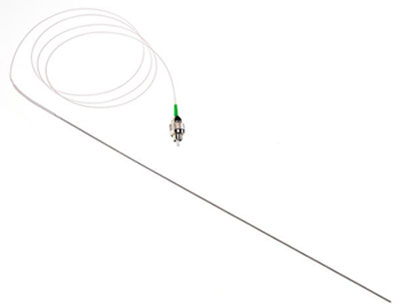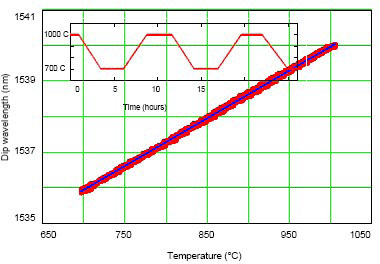Fiber Optic Temperature Sensor
 http://www.chiralphotonics.com
http://www.chiralphotonics.com
Fiber Optic Temperature Sensor
This HTS-1000 sensor enables fiber optic temperature measurements up to 1000 °C.
How It Works

The HTS-1000 is based on Chiral Photonics’ chiral diffraction grating, fabricated by twisting a fiber as it is passed through a miniature heat zone to produce a distinct dip in the transmission spectrum. The spectral position of the dip in this chiral fiber changes with temperature allowing it to be used as a temperature sensor.
In addition to the traditional benefits of fiber optic sensors, including immunity to electromagnetic interference, better environmental stability and enhanced remote sensing as compared to traditional electronic sensors, the HTS-1000 extends these benefits to ultra-high temperature applications, ranging from turbine engine test and development to refinery process monitoring and control.
Specifications
| Specifications | |
|---|---|
| Temperature Range | Up to at least 1000 °C |
| Accuracy | 1% |
| Sensitivity | 0.01 nm/°C (nominal) |
| Drift (measured over more than 1400 hours at 900 °C) | 0.0005 °C/hr (nominal) |
| Probe (metal sheathing) Length | 300 mm standard - Other lengths available upon request |
| Sensor/Grating Length | 15 mm - Other lengths available upon request |
| Sensor Placement | 25 mm from probe tip - Other configurations available upon request |
| Connector Type | FC/APC - Other connectors available upon request |
| Packaging | See Drawing - Other configurations available upon request |
Temperature testing was carried out in a computer-controlled high-temperature oven in which the temperature was also monitored by a thermocouple. Both long-term temperature stability and temperature sensitivity were tested using a fiber optic interrogator to monitor sensors as they were cycled from room temperature to 1000 °C. The characteristic spectral dip wavelength shifts to the red by approximately 1.3 nm as the temperature is raised by 100 °C. The figure below shows the wavelength of transmission dip of a chiral fiber versus temperature. The temperature was cycled five times from 700 °C to 1000 °C in the course of 24 hours, dwelling for 3 hours at these temperatures. The inset shows the temperature variations. As seen in the figure below, the HTS-1000 is capable of reliably measuring temperature up to 1000 °C with better than 1% accuracy. Drift measured over more than 1400 hours at 900 °C was 0.0005 °C/hr.



